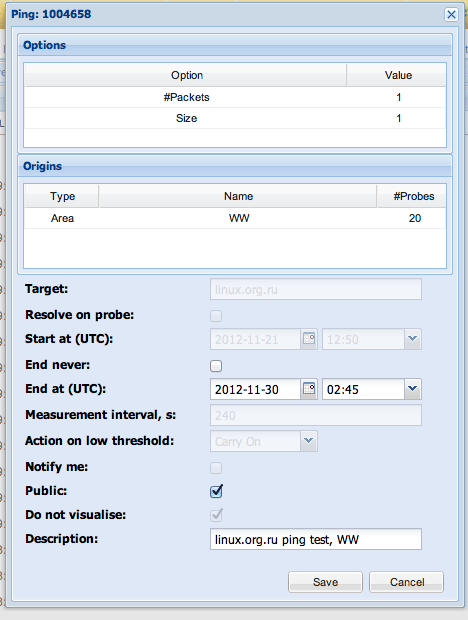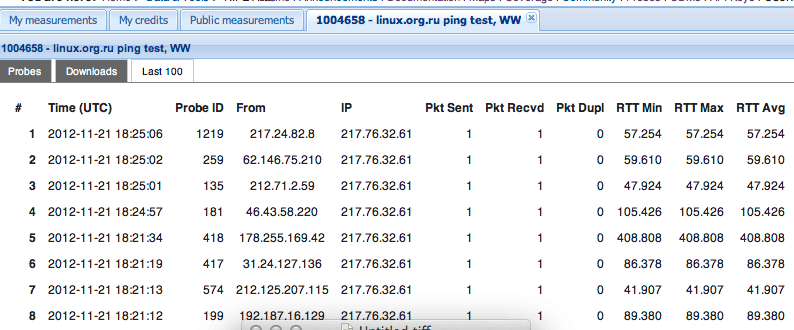Atlas RIPE probe: use
A month ago, I wrote an article about a probe that I brought from the ENOG-4 conference. A side effect of the article was the download of the ordered probes, which can be seen on the graph of statistics of the distribution of probes by users.
There were two main questions that arose in the process of contemplating the device: what is inside and how can it be used in practice?
So, inside there is a rather expensive and relatively flexible Lantronix Xport-Pro device with its own USB power cable. The device costs more than $ 60 without a case and strapping, and in fact they are paid for by LIRs. For this money, we get a small linux-computer, which in principle can make many measurements.
')
However, what is available to us as a user? Since there are many probes, they can be used for evil, so the RIPE introduced the credit system: “loans” are accrued for continuous operation, which can then be spent on changes. Here is the history of charging for 1 constantly working (my) probe:

We can spend these loans on test creation. The “normal” user can access only the basic test versions with little or no opportunity to strongly customize requests:

As the documentation suggests, access to the most interesting type of request, HTTP, is limited to an unspecified attribute. The test can be performed by filtering the probes by some criteria, for example, by region. For one time can not use more than 30 probes. Here are the settings for the ping-test linux.org.ru:

As a result, we can look at the probes participating in the test and recent requests:


The measurement results themselves can be downloaded as JSON. Not much? I think so too. For example, I would be interested to look at the download speed of URIs from various points in the world or TCP traceroute, given the power and price of the device.
There were two main questions that arose in the process of contemplating the device: what is inside and how can it be used in practice?
So, inside there is a rather expensive and relatively flexible Lantronix Xport-Pro device with its own USB power cable. The device costs more than $ 60 without a case and strapping, and in fact they are paid for by LIRs. For this money, we get a small linux-computer, which in principle can make many measurements.
')
However, what is available to us as a user? Since there are many probes, they can be used for evil, so the RIPE introduced the credit system: “loans” are accrued for continuous operation, which can then be spent on changes. Here is the history of charging for 1 constantly working (my) probe:

We can spend these loans on test creation. The “normal” user can access only the basic test versions with little or no opportunity to strongly customize requests:

As the documentation suggests, access to the most interesting type of request, HTTP, is limited to an unspecified attribute. The test can be performed by filtering the probes by some criteria, for example, by region. For one time can not use more than 30 probes. Here are the settings for the ping-test linux.org.ru:

As a result, we can look at the probes participating in the test and recent requests:


The measurement results themselves can be downloaded as JSON. Not much? I think so too. For example, I would be interested to look at the download speed of URIs from various points in the world or TCP traceroute, given the power and price of the device.
Source: https://habr.com/ru/post/159701/
All Articles